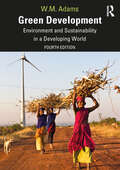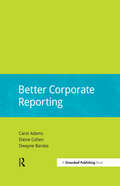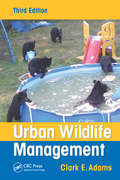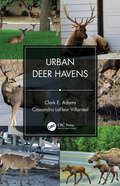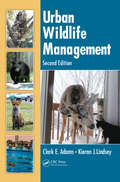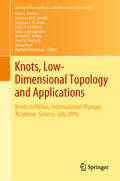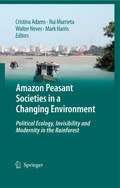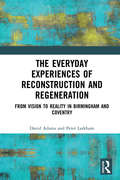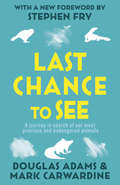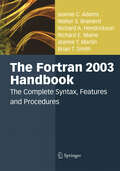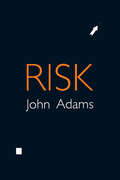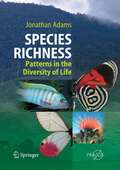- Table View
- List View
Green Development: Environment and Sustainability in a Developing World
by Bill AdamsThe concept of sustainability lies at the core of the challenge of environment and development, and the way governments, business and environmental groups respond to it. Green Development provides a clear and coherent analysis of sustainable development in both theory and practice. Green Development explores the origins and evolution of mainstream thinking about sustainable development and offers a critique of the ideas behind them. It draws a link between theory and practice by discussing the nature of the environmental degradation and the impacts of development. It argues that, ultimately, ‘green’ development has to be about political economy, about the distribution of power, and not about environmental quality. Its focus is strongly on the developing world. The fourth edition retains the broad structure of previous editions, but has been updated to reflect advances in ideas and changes in international policy. Greater attention has been given to the political ecology of development, market-based and neoliberal environmentalism, and degrowth. This fully revised edition discusses: the origins of thinking about sustainability and sustainable development, and its evolution to the present day; the ideas that dominate mainstream sustainable development (including natural capital, the green economy, market environmentalism and ecological modernisation); critiques of mainstream ideas and of neoliberal framings of sustainability, and alternative ideas about sustainability that challenge ‘business as usual’ thinking, such as arguments about limits to growth and calls for degrowth; the dilemmas of sustainability in the context of forests, desertification, food and farming, biodiversity conservation and dam construction; the challenge of policy choices about sustainability, particularly between reformist and radical responses to the contemporary global dilemmas. Green Development offers clear insights into the challenges of environmental sustainability, and social and economic development. It is unique in offering a synthesis of theoretical ideas on sustainability and in its coverage of the extensive literature on environment and development around the world. The book has proved its value to generations of students as an authoritative, thought-provoking and readable guide to the field of sustainable development.
Green Development: Environment and Sustainability in a Developing World
by Bill AdamsThe concept of sustainability lies at the core of the challenge of environment and development, and the way governments, business and environmental groups respond to it. Green Development provides a clear and coherent analysis of sustainable development in both theory and practice. Green Development explores the origins and evolution of mainstream thinking about sustainable development and offers a critique of the ideas behind them. It draws a link between theory and practice by discussing the nature of the environmental degradation and the impacts of development. It argues that, ultimately, ‘green’ development has to be about political economy, about the distribution of power, and not about environmental quality. Its focus is strongly on the developing world. The fourth edition retains the broad structure of previous editions, but has been updated to reflect advances in ideas and changes in international policy. Greater attention has been given to the political ecology of development, market-based and neoliberal environmentalism, and degrowth. This fully revised edition discusses: the origins of thinking about sustainability and sustainable development, and its evolution to the present day; the ideas that dominate mainstream sustainable development (including natural capital, the green economy, market environmentalism and ecological modernisation); critiques of mainstream ideas and of neoliberal framings of sustainability, and alternative ideas about sustainability that challenge ‘business as usual’ thinking, such as arguments about limits to growth and calls for degrowth; the dilemmas of sustainability in the context of forests, desertification, food and farming, biodiversity conservation and dam construction; the challenge of policy choices about sustainability, particularly between reformist and radical responses to the contemporary global dilemmas. Green Development offers clear insights into the challenges of environmental sustainability, and social and economic development. It is unique in offering a synthesis of theoretical ideas on sustainability and in its coverage of the extensive literature on environment and development around the world. The book has proved its value to generations of students as an authoritative, thought-provoking and readable guide to the field of sustainable development.
Electron Backscatter Diffraction in Materials Science
by Brent L. Adams Mukul Kumar Adam J. Schwartz David P. FieldElectron backscatter diffraction is a very powerful and relatively new materials characterization technique aimed at the determination of crystallographic texture, grain boundary character distributions, lattice strain, phase identification, and much more. The purpose of this book is to provide the fundamental basis for electron backscatter diffraction in materials science, the current state of both hardware and software, and illustrative examples of the applications of electron backscatter diffraction to a wide-range of materials including undeformed and deformed metals and alloys, ceramics, and superconductors. The text has been substantially revised from the first edition, and the authors have kept the format as close as possible to the first edition text. The new developments covered in this book include a more comphrensive coverage of the fundamentals not covered in the first edition or other books in the field, the advances in hardware and software since the first edition was published, and current examples of application of electron backscatter diffraction to solve challenging problems in materials science and condensed-matter physics.
Lithic Materials and Paleolithic Societies
by Brian Adams Brooke BladesLithic Materials and Paleolithic Societies provides a detailed examination of the Paleolithic procurement and utilization of the most durable material in the worldwide archaeological record. The volume addresses sites ranging in age from some of the earliest hominin occupations in eastern and southern Africa to late Pleistocene and post-Pleistocene occupations in North American and Australia. The Early Paleolithic in India and the Near East, the Middle Paleolithic in Europe, and the Late Paleolithic in Europe and eastern Asia are also considered. The authors include established researchers who provide important synthetic statements updated with new information. Recent data are reported, often by younger scholars who are becoming respected members of the international research community. The authors represent research traditions from nine countries and therefore provide insight into the scholarly present as well as the Paleolithic past. Attempts are frequently made to relate lithic procurement and utilization to the organization of societies and even broader concerns of hominin behaviour. The volume re-evaluates existing interpretations in some instances by updating previous work of the authors and offers provocative new interpretations that at times call into question some basic assumptions of the Paleolithic. This book will be invaluable reading for advanced students and researchers in the fields of palaeolithic archaeology, geoarchaeology, and anthropology.
Understanding Integrated Reporting: The Concise Guide to Integrated Thinking and the Future of Corporate Reporting
by Carol AdamsIntegrated Reporting is the big new development in corporate reporting that everyone is talking about. Why? Quite simply, Integrated Reporting marks a paradigm shift in the way companies and other organizations think about business models and the creation of value. Integrated Reporting promotes long term thinking about value-creation and stewardship across a broad base of interdependent capitals – financial, manufactured, human, intellectual, natural, and social and relationship.With updated references and case studies to take account of the latest developments in Integrated Reporting, this book provides a practical and expert distillation of for IR professionals.Internationally renowned sustainability reporting expert and accountant Dr Carol Adams explains in simple terms what is and how to do it; how it links with other reporting frameworks and what it means in terms of thinking and processes. You'll also get a clear business case for IR and insights and best practice examples from leading integrated reporters. Integrated Reporting is not just for companies.This book demonstrates how integrated thinking and IR can benefit many other organizations whose success and influence depends on relationships and partnerships.
Understanding Integrated Reporting: The Concise Guide to Integrated Thinking and the Future of Corporate Reporting
by Carol AdamsIntegrated Reporting is the big new development in corporate reporting that everyone is talking about. Why? Quite simply, Integrated Reporting marks a paradigm shift in the way companies and other organizations think about business models and the creation of value. Integrated Reporting promotes long term thinking about value-creation and stewardship across a broad base of interdependent capitals – financial, manufactured, human, intellectual, natural, and social and relationship.With updated references and case studies to take account of the latest developments in Integrated Reporting, this book provides a practical and expert distillation of for IR professionals.Internationally renowned sustainability reporting expert and accountant Dr Carol Adams explains in simple terms what is and how to do it; how it links with other reporting frameworks and what it means in terms of thinking and processes. You'll also get a clear business case for IR and insights and best practice examples from leading integrated reporters. Integrated Reporting is not just for companies.This book demonstrates how integrated thinking and IR can benefit many other organizations whose success and influence depends on relationships and partnerships.
Better Corporate Reporting
by Carol Adams Elaine Cohen Dwayne BarakaBetter Corporate Reporting outlines the latest frameworks for enhancing non-financial and sustainability reporting. It shows you how to integrate non-financial data into your reporting and overall strategy, creating long-term value, trust and transparency. It includes guides to: the International Integrated Reporting Council's new framework; the Global Reporting Initiative's G4 framework; and a detailed look at the concept at the heart of both of these new frameworks, materiality. It is the compilation of 3 bestselling sustainability guides on sustainability reporting.Understanding Integrated Reporting provides a practical and expert distillation of the new IR framework released by the International Integrated Reporting Council in December 2013. It explains what IR is and how to do it; how it links with other reporting frameworks and what it means in terms of thinking and processes. You'll also get a clear business case for IR and insights and best practice examples from leading integrated reporters. The Global Reporting Initiative (GRI) G4 Sustainability Reporting Framework was launched in May 2013. In Understanding G4, corporate reporting veteran Elaine Cohen presents an easy-to-follow review of everything any organization needs to know to decide whether to use the G4 Framework and if so, how. Materiality is the lynch-pin that can align your sustainability initiatives with your overall strategy. Making Sustainability Matter shows you how to identify your organization's most material sustainability issues, allocate resources to sustainability initiatives for optimal returns; connect your communications and reporting to materiality, and; clarify which issues are important to your stakeholders. Materiality is a core concept in both the GRI's new G4 framework the IIRC's new Integrated Reporting framework.
Better Corporate Reporting (Doshorts Ser.)
by Carol Adams Elaine Cohen Dwayne BarakaBetter Corporate Reporting outlines the latest frameworks for enhancing non-financial and sustainability reporting. It shows you how to integrate non-financial data into your reporting and overall strategy, creating long-term value, trust and transparency. It includes guides to: the International Integrated Reporting Council's new framework; the Global Reporting Initiative's G4 framework; and a detailed look at the concept at the heart of both of these new frameworks, materiality. It is the compilation of 3 bestselling sustainability guides on sustainability reporting.Understanding Integrated Reporting provides a practical and expert distillation of the new IR framework released by the International Integrated Reporting Council in December 2013. It explains what IR is and how to do it; how it links with other reporting frameworks and what it means in terms of thinking and processes. You'll also get a clear business case for IR and insights and best practice examples from leading integrated reporters. The Global Reporting Initiative (GRI) G4 Sustainability Reporting Framework was launched in May 2013. In Understanding G4, corporate reporting veteran Elaine Cohen presents an easy-to-follow review of everything any organization needs to know to decide whether to use the G4 Framework and if so, how. Materiality is the lynch-pin that can align your sustainability initiatives with your overall strategy. Making Sustainability Matter shows you how to identify your organization's most material sustainability issues, allocate resources to sustainability initiatives for optimal returns; connect your communications and reporting to materiality, and; clarify which issues are important to your stakeholders. Materiality is a core concept in both the GRI's new G4 framework the IIRC's new Integrated Reporting framework.
Urban Wildlife Management
by Clark E. AdamsWinner of the 2018 TWS Wildlife Publication Awards in the authored book category Urban development is one of the leading worldwide threats to conserving biodiversity. In the near future, wildlife management in urban landscapes will be a prominent issue for wildlife professionals. This new edition of Urban Wildlife Management continues the work of its predecessors by providing a comprehensive examination of the issues that increase the need for urban wildlife management, exploring the changing dynamics of the field while giving historical perspectives and looking at current trends and future directions. The book examines a range of topics on human interactions with wildlife in urbanized environments. It focuses not only on ecological matters but also on political, economic, and societal issues that must be addressed for successful management planning. This edition features an entirely new section on urban wildlife species, including chapters on urban communities, herpetofauna, birds, ungulates, mammals, carnivores, and feral and introduced species. The third edition features Five new chapters 12 updated chapters Four new case studies Seven new appendices and species profiles 90 new figures A comprehensive analysis of terrestrial vertebrate locations by state and urban observations Each chapter opens with a set of key concepts which are then examined in the following discussions. Suggested learning experiences to enhance knowledge conclude each chapter. The species profiles cover not only data about the animal concerned but also detail significant current management issues related to the species. An updated and expanded teaching tool, Urban Wildlife Management, Third Edition identifies the challenges and opportunities facing wildlife in urban communities as well as factors that promote or threaten their presence. It gives both students and professionals a solid grounding in the required fundamental ecological principles for understanding the effects of human-made environments on wildlife.
Urban Wildlife Management
by Clark E. AdamsWinner of the 2018 TWS Wildlife Publication Awards in the authored book category Urban development is one of the leading worldwide threats to conserving biodiversity. In the near future, wildlife management in urban landscapes will be a prominent issue for wildlife professionals. This new edition of Urban Wildlife Management continues the work of its predecessors by providing a comprehensive examination of the issues that increase the need for urban wildlife management, exploring the changing dynamics of the field while giving historical perspectives and looking at current trends and future directions. The book examines a range of topics on human interactions with wildlife in urbanized environments. It focuses not only on ecological matters but also on political, economic, and societal issues that must be addressed for successful management planning. This edition features an entirely new section on urban wildlife species, including chapters on urban communities, herpetofauna, birds, ungulates, mammals, carnivores, and feral and introduced species. The third edition features Five new chapters 12 updated chapters Four new case studies Seven new appendices and species profiles 90 new figures A comprehensive analysis of terrestrial vertebrate locations by state and urban observations Each chapter opens with a set of key concepts which are then examined in the following discussions. Suggested learning experiences to enhance knowledge conclude each chapter. The species profiles cover not only data about the animal concerned but also detail significant current management issues related to the species. An updated and expanded teaching tool, Urban Wildlife Management, Third Edition identifies the challenges and opportunities facing wildlife in urban communities as well as factors that promote or threaten their presence. It gives both students and professionals a solid grounding in the required fundamental ecological principles for understanding the effects of human-made environments on wildlife.
Urban Deer Havens
by Clark E. Adams Cassandra LaFleur VillarrealUrban Deer Havens consists of a thorough examination of selected cervid (deer) species that are known to inhabit urban communities in the United States. The deer species that are included in this presentation consisted of white-tailed (Odocoileus virginianus), Key deer (O. v. clavium), moose (Alces alces), elk (Cervus elaphus), mule (Odocoileus hemionus), and black-tailed deer (O. h. columbianus). This book is the first attempt to examine the similarities and differences in those factors that allow the selected cervids to exist and thrive in urban habitats. This information has never been collected, collated, reviewed, and published under one cover document. Yet, all five are known to inhabit urban communities within their geographic range. The lack of information concerning several important examples of urban cervids in conjunction with a proliferation of information on white-tailed deer only is an incomplete and biased presentation. This book is the first comprehensive source of information on urban deer management, which includes a broad assemblage of urban cervids. The overall objective of this book is to provide a more holistic examination of urban cervids. For example, it examines the similarities and differences of the environmental impacts, management strategies, and human dimensions considerations concerning urban cervids in general, and using specific examples. Urban Deer Havens features four chapters that include: Urban deer census techniques and population dynamics Comprehensive tables that review urban community deer management plans National and state-wide estimates the five selected cervids Laws and regulations concerning urban deer Lethal and nonlethal management options for managing deer Steps for managing urban deer populations Examples of urban deer management efforts
Urban Deer Havens
by Clark E. Adams Cassandra LaFleur VillarrealUrban Deer Havens consists of a thorough examination of selected cervid (deer) species that are known to inhabit urban communities in the United States. The deer species that are included in this presentation consisted of white-tailed (Odocoileus virginianus), Key deer (O. v. clavium), moose (Alces alces), elk (Cervus elaphus), mule (Odocoileus hemionus), and black-tailed deer (O. h. columbianus). This book is the first attempt to examine the similarities and differences in those factors that allow the selected cervids to exist and thrive in urban habitats. This information has never been collected, collated, reviewed, and published under one cover document. Yet, all five are known to inhabit urban communities within their geographic range. The lack of information concerning several important examples of urban cervids in conjunction with a proliferation of information on white-tailed deer only is an incomplete and biased presentation. This book is the first comprehensive source of information on urban deer management, which includes a broad assemblage of urban cervids. The overall objective of this book is to provide a more holistic examination of urban cervids. For example, it examines the similarities and differences of the environmental impacts, management strategies, and human dimensions considerations concerning urban cervids in general, and using specific examples. Urban Deer Havens features four chapters that include: Urban deer census techniques and population dynamics Comprehensive tables that review urban community deer management plans National and state-wide estimates the five selected cervids Laws and regulations concerning urban deer Lethal and nonlethal management options for managing deer Steps for managing urban deer populations Examples of urban deer management efforts
Urban Wildlife Management
by Clark E. Adams Kieran J. LindseyWhen the first edition of Urban Wildlife Management was published two years ago, it provided conservationists, ecologists, and wildlife professionals with a welcome shift in the way that interactions between humans and wildlife were viewed and managed. Instead of focusing on ways to evict or eradicate wildlife encroached on by urban development, th
Knots, Low-Dimensional Topology and Applications: Knots in Hellas, International Olympic Academy, Greece, July 2016 (Springer Proceedings in Mathematics & Statistics #284)
by Colin C. Adams Cameron McA. Gordon Vaughan F. R. Jones Louis H. Kauffman Sofia Lambropoulou Kenneth C. Millett Jozef H. Przytycki Renzo Ricca Radmila SazdanovicThis proceedings volume presents a diverse collection of high-quality, state-of-the-art research and survey articles written by top experts in low-dimensional topology and its applications. The focal topics include the wide range of historical and contemporary invariants of knots and links and related topics such as three- and four-dimensional manifolds, braids, virtual knot theory, quantum invariants, braids, skein modules and knot algebras, link homology, quandles and their homology; hyperbolic knots and geometric structures of three-dimensional manifolds; the mechanism of topological surgery in physical processes, knots in Nature in the sense of physical knots with applications to polymers, DNA enzyme mechanisms, and protein structure and function. The contents is based on contributions presented at the International Conference on Knots, Low-Dimensional Topology and Applications – Knots in Hellas 2016, which was held at the International Olympic Academy in Greece in July 2016. The goal of the international conference was to promote the exchange of methods and ideas across disciplines and generations, from graduate students to senior researchers, and to explore fundamental research problems in the broad fields of knot theory and low-dimensional topology. This book will benefit all researchers who wish to take their research in new directions, to learn about new tools and methods, and to discover relevant and recent literature for future study.
Amazon Peasant Societies in a Changing Environment: Political Ecology, Invisibility and Modernity in the Rainforest
by Cristina Adams Mark Harris Rui S. S. Murrieta Walter A. NevesAmazonia is never quite what it seems. Despite regular attention in the media and numerous academic studies the Brazilian Amazon is rarely appreciated as a historical place home to a range of different societies. Often left invisible are the families who are making a living from the rivers and forests of the region. Broadly characterizing these people as peasants Amazon Peasant Societies in a Changing Environment seeks to bring together research by anthropologists, historians, political ecologists and biologists. A new paradigm emerges which helps understand the way in which Amazonian modernity has developed. This book addresses a comprehensive range of questions from the politics of conservation and sustainable development to the organization of women’s work and the diet and health of Amazonian people. Apart from offering an analysis of a neglected aspect of Amazonia this collection represents a unique interdisciplinary exercise on the nature of one of the most beguiling regions of the world.
The Everyday Experiences of Reconstruction and Regeneration: From Vision to Reality in Birmingham and Coventry
by David Adams Peter LarkhamSet within a wider British and international context of post-war reconstruction, The Everyday Experiences of Reconstruction and Regeneration focuses on such debates and experiences in Birmingham and Coventry as they recovered from Second World War bombings and post-war industrial collapse. Including numerous images, Adams and Larkham explore the initial development of the post-Second World War reconstruction projects, which so substantially changed the face of the cities and provided radical new identities. Exploring these cities throughout the post-war period brings into sharp focus the duality of contemporary approaches to regeneration, which often criticise mid-twentieth century ’poorly-conceived’ planning and architectural projects for producing inhuman and unsympathetic schemes, while proposing exactly the type of large-scale regeneration that may potentially create similar issues in the future. This book would be beneficial for academics and students of planning and urban design, particularly those with an interest in post-catastrophe or large-scale reconstruction projects within cities.
The Everyday Experiences of Reconstruction and Regeneration: From Vision to Reality in Birmingham and Coventry
by David Adams Peter LarkhamSet within a wider British and international context of post-war reconstruction, The Everyday Experiences of Reconstruction and Regeneration focuses on such debates and experiences in Birmingham and Coventry as they recovered from Second World War bombings and post-war industrial collapse. Including numerous images, Adams and Larkham explore the initial development of the post-Second World War reconstruction projects, which so substantially changed the face of the cities and provided radical new identities. Exploring these cities throughout the post-war period brings into sharp focus the duality of contemporary approaches to regeneration, which often criticise mid-twentieth century ’poorly-conceived’ planning and architectural projects for producing inhuman and unsympathetic schemes, while proposing exactly the type of large-scale regeneration that may potentially create similar issues in the future. This book would be beneficial for academics and students of planning and urban design, particularly those with an interest in post-catastrophe or large-scale reconstruction projects within cities.
Last Chance To See
by Douglas Adams Mark Carwardine'Douglas Adams' genius was in using comedy to make serious points about the world' IndependentAfter years of reflecting on the absurdities of life on other planets, Douglas Adams teamed up with zoologist Mark Carwardine to find out what was happening to life on this one. Together they lead us on an unforgettable journey across the world in search of exotic, endangered creatures - animals that they may never get another chance to see. They encounter the animal kingdom in its stunning beauty, astonishing variety, and imminent peril: the giant Komodo dragon of Indonesia, the helpless but lovable Kakapo of New Zealand, the blind river dolphins of China, the white rhinos of Zaire, the rare birds of Mauritius island in the Indian Ocean. Both funny and poignant, Last Chance to See is the tale of an unforgettable wildlife odyssey - and a timely reminder of all that we must protect.
Cosmic Update: Dark Puzzles. Arrow of Time. Future History (Multiversal Journeys)
by Fred Adams Thomas Buchert Laura Mersini-Houghton"...The Multiversal book series is equally unique, providing book-length extensions of the lectures with enough additional depth for those who truly want to explore these fields, while also providing the kind of clarity that is appropriate for interested lay people to grasp the general principles involved." - Lawrence M. KraussCosmic Update Covers:A novel approach to uncover the dark faces of the Standard Model of cosmology.The possibility that Dark Energy and Dark Matter are manifestations of the inhomogeneous geometry of our Universe.On the history of cosmological model building and the general architecture of cosmological modes.Illustrations on the Large Scale Structure of the Universe.A new perspective on the classical static Einstein Cosmos.Global properties of World Models including their Topology.The Arrow of Time in a Universe with a Positive Cosmological Constant.Exploring the consequences of a fundamental Cosmological Constant for our Universe. Exploring why the current observed acceleration of the Universe may not be its final destiny.Demonstrating that nature forbids the existence of a pure Cosmological Constant.Our current understanding of the long term (in time scales that greatly exceed the current age of the Universe) future of the Universe.The long term fate and eventual destruction of the astrophysical objects that populate the universe -- including clusters, galaxies, stars, planets, and black holes. The material is presented in a layperson-friendly language followed by addition technical sections that explain the basic equations and principles. This feature is very attractive to readers who want to learn more about the theories involved beyond the basic description. "Multiversal Journeys™ is a trademark of Farzad Nekoogar and Multiversal Journeys, a 501 (c) (3) nonprofit organization."
The Fortran 2003 Handbook: The Complete Syntax, Features and Procedures
by Jeanne C. Adams Walter S. Brainerd Richard A. Hendrickson Richard E. Maine Jeanne T. Martin Brian T. SmithThe Fortran 2003 Handbook is a definitive and comprehensive guide to Fortran 2003 and its use. Fortran 2003, the latest standard version of Fortran, has many excellent features that assist the programmer in writing efficient, portable and maintainable programs. This all-inclusive volume offers a reader-friendly, easy-to-follow and informal description of Fortran 2003, and has been developed to provide not only a readable explanation of features, but also some rationale for the inclusion of features and their use. This highly versatile handbook is intended for anyone who wants a comprehensive survey of Fortran 2003.
Risk: Living With Perils In The 21st Century (Advances In Natural And Technological Hazards Research Ser. #33)
by John AdamsRisk compensation postulates that everyone has a "risk thermostat" and that safety measures that do not affect the setting of the thermostat will be circumvented by behaviour that re-establishes the level of risk with which people were originally comfortable. It explains why, for example, motorists drive faster after a bend in the road is straightened. Cultural theory explains risk-taking behaviour by the operation of cultural filters. It postulates that behaviour is governed by the probable costs and benefits of alternative courses of action which are perceived through filters formed from all the previous incidents and associations in the risk-taker's life.; "Risk" should be of interest to many readers throughout the social sciences and in the world of industry, business, engineering, finance and public administration, since it deals with a fundamental part of human behaviour that has enormous financial and economic implications.
Risk
by John AdamsRisk compensation postulates that everyone has a "risk thermostat" and that safety measures that do not affect the setting of the thermostat will be circumvented by behaviour that re-establishes the level of risk with which people were originally comfortable. It explains why, for example, motorists drive faster after a bend in the road is straightened. Cultural theory explains risk-taking behaviour by the operation of cultural filters. It postulates that behaviour is governed by the probable costs and benefits of alternative courses of action which are perceived through filters formed from all the previous incidents and associations in the risk-taker's life.; "Risk" should be of interest to many readers throughout the social sciences and in the world of industry, business, engineering, finance and public administration, since it deals with a fundamental part of human behaviour that has enormous financial and economic implications.
Species Richness: Patterns in the Diversity of Life (Springer Praxis Books)
by Jonathan AdamsThis is a readable, informative and up-to-date account of the patterns and controls on biodiversity. The author describes major trends in species richness, along with uncertainties in current knowledge. The various possible explanations for past and present species patterns are discussed and explained in an even-handed and accessible way. The implications of global climate change and habitat loss are considered, along with current strategies for preserving what we have. This book examines the state of current understanding of species richness patterns and their explanations. As well as the present day world, it deals with diversification and extinction, in the conservation of species richness, and the difficulties of assessing how many species remain to be discovered. The scientifically compelling subject of vegetation-climate interaction is considered in depth. Written in an accessible style, the author offers an up-to-date, rigorous and yet eminently comprehensible overview of the ecology and biogeography of species richness. He departs from the often heavy approach of earlier texts, without sacrificing rigor and depth of information and analysis. Prefacing with the aims of the book, Chapter 1 opens with an explanation of latitudinal gradients, including a description of major features of the striking gradients in species richness, exceptions to the rule, explanations, major theories and field and experimental tests. The following chapter plumbs the depth of time, including the nature of the fossil record, broad timescale diversity patterns, ecosystem changes during mass extinctions and glaciations and their influence on species richness. Chapters 3 and 4 consider hotspots and local scale patterns in species richness while Chapter 5 looks at the limitations and uncertainties on current estimates of richness, the last frontiers of species diversity and the process of identifying new life forms. The last three chapters cover humans and extinctions in history and prehistory, current habitat and global change, including the greenhouse effect, and the race to preserve what we still have, including parks, gene banks and laws.
Vegetation-Climate Interaction: How Vegetation Makes the Global Environment (Springer Praxis Books)
by Jonathan AdamsAn accessible account of the ways in which the world's plant life affects the climate. It covers everything from tiny local microclimates created by plants to their effect on a global scale. If you’ve ever wondered how vegetation can create clouds, haze and rain, or how plants have an impact on the composition of greenhouse gases, then this book is required reading.
Vegetation-Climate Interaction: How Plants Make the Global Environment (Springer Praxis Books)
by Jonathan AdamsAn accessible account of the ways in which the world's plant life affects the climate. It covers everything from tiny local microclimates created by plants to their effect on a global scale. If you’ve ever wondered how vegetation can create clouds, haze and rain, or how plants have an impact on the composition of greenhouse gases, then this book is required reading.
